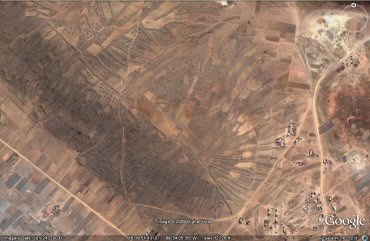
|

|
||
Atlantis Bolivia - page 4, conclusion
"New opinions often appear first as jokes and fancies, then as blasphemies and treason, then as questions open to discussion, and finally as established truths." - George Bernard Shaw
A two part solution
Since there is no 100% solution that relates a time, place and events to Atlantis in the exact manner Plato
described, we should consider, as sugested by the historian Robert Graves (The Greek Myths) the possibility that
the story of Atlantis is a composite story incorporating elements from other legends which have been grafted onto
the Atlantis geographical description.
Plato was not writing a factual historical document, but a treatise to illustrate how his ideal state with a theoretical Athens could defeat a superior force in time of war. Just like any modern writer, he would probably draw various sources together and polish them up into his final account.
Pages one to three of this site demonstrate that the geographic description of Atlantis belongs to South America, particularly Bolivia, the Altiplano, Lake Poopo and the circular formation at Pampa Aullagas.
But what of the horses, chariots, the fleet of 1200 ships etc which Plato said came from Atlantis? And what of the date of 9,000 years before Solon, when modern archaeology tells us there was no ancient Athens and no ancient Egypt?
The dating of Atlantis
and the wars of Atlantis
The dating is a difficult question, some factors point to an early date, such as the mastodons, also at an earlier period, the climate on the Altiplano would have been warmer than it is today. The Altiplano was covered in a giant inland sea known as Lake Tauca which lasted from 16,000 to around 13,000BC, then there may have been a dry spell when the Altiplano would have been covered in fertile mud until around 11,000BC when the Altiplano was covered by the shallower lake Coipasa which lasted a further 1500 years. So there is a flooding event which fits in roughly with Plato's date.

Above, lake Tauca was at just the right elevation to enter the rings of Pampa Aullagas forming natural harbours.

Above, flooding of the volcano at Pampa Aullagas by the paleolakes.
click for page on flooding dates
Spanish historian Agustin Zarate, writing in 1555 in "The History and Discovery of Peru" introduces the story of Atlantis and notes "Plato says... the power of the waters so increased in those days so that in a day and night the island was submerged, drowning the land and population..." - that is to say, Atlantis disappeared not by sinking into the sea as would be the case due to subsidence of the island, but because the waters increased, thus submerging the island.
Evidence of this flooding was also found by Posnansky, who documents that at one time the lakes above lake Titicaca flooded to bursting point, the waters poured down into lake Titicaca causing that lake to flood and drown the city of Tiwanaku, the waters then continued south along the Altiplano which according to Posnansky also sank in elevation, leaving the sloping strand line of the former lakes.
However Plato tells us that "9,000 is the sum of years since the war occurred" - and he is describing the foundation of Athens and the "finest of the deeds the Greeks achieved." So the real question is whether both these events, the sinking of the Atlantis plain and the defeat of the invading armies by the Athenian Greeks really both happened at the same time, or was one earlier and one later or both at a later period?
The number of ships involved may provide a further clue and in the description of the Confederation of Atlantis
ruling Libya up to the borders of Egypt and Europe up to Tyrennia in Italy, then attempting to enslave the
whole of the eastern Mediterranean.
If we substitute lunar "years" (sidereal lunar months) for solar years, this would bring the date down to around 1260BC and the Trojan war which might correspond to the "finest of the deeds the Greeks achieved"

The Trojan War was the beginning of a series of wars which ultimately led to the destruction of the Persian
empire at the hands of Alexander.
The "confederated nations attempting to enslave the eastern Mediterranean" could be the armies of the Persian Empire (around 480BC) or at an earlier date, what are usually called "the Sea Peoples" who attacked Egypt in 1220 and 1186BC, attempting to enter Egypt both by sea and with land armies all of which were defeated by the Egyptian pharoahs.





Above left, headgear of Sea People warrior, next, headdress of amazonian Indians, then headgear
of Tula warrior, Mexico,
then headdress of Tiwanaku warrior, Bolivia.

The boats of the Sea Peoples are ambushed and pulled over with grappling irons.
Prisoners were taken and some, such as the Philistines, resettled in Palestine which is named after them.
The Sea Peoples were a confederation of various nations and so far it has not been possible for archaeologists to identify exactly where they came from. The Egyptians said they came from "The Isles in the midst of the Sea".
This is usually assumed to mean Mediterranean islands such as Sardinia, Sicily, Malta, Cyprus etc but at the same time there were huge numbers of them considering they supposedly came from these relatively small islands, unless these islands were used as intermediary bases... the Sea Peoples invaded Egypt both from Palestine and from Libya, bringing to mind Plato's description that the Confederation of Atlantis contolled Libya up to the border of Egypt and Europe up to Tuscany. The use of feathered headdresses combined with the discovery of coca in the mummies of Egyptian pharoahs suggests there may have been also a South American connection i.e. with Atlantis, the Atlantic Island. And what motivation would Amazonian Indians have for sailing over and attacking Egypt? Possibly they were in an alliance with the Persians or perhaps their homelands were becoming uninhabitable due to increased rainfall and flooding .... the Amazonian basin and Beni regions of Bolivia flood repeatedly each year and increased water levels may have driven out massive numbers of these feathered headdressed invaders.
American drugs (coca and tobacco) in Egyptian Mummies, click for report
If we go back to Herodotus, the Greek historian (484 BC– 425 BC) writing in his Histories tells us all about a great invasion of Greece by the Persians and how they were defeated by the Greeks. He tells us that the Persians had a great fleet of 1207 ships ...
Now wasn't that the same number the fleet of Atlantis was supposed to have, also the same number the Greeks had against the Trojans in the Trojan war??!!!
And could this great invasion fleet of the Persians be the same that Plato used to base the military elements of his Atlantis story upon, since they in turn were beaten by the Greeks both on land and by sea, so that was "the finest achievement of the Greeks"?

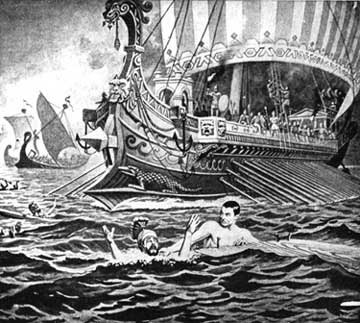
Xerxes sees his fleet being smashed by the Greeks at the battle of Salamis.
Although this latter event (around 480B.C.) was later than when Solon visited Egypt it was also before Plato wrote his Atlantis story, so could have inspired him in his description of the war between Atlantis and Athens.
After all, his stated purpose in the Atlantis story was to find a worthy enemy that his ideal state of Athens could be seen to have defeated in war, to show how good his theoretical system of government for Athens would be, that is, not a democratic Athens but an Athens governed by philosopher kings and guardians. So for that reason, the date of the war is described as 9,000 "years" earlier in order to give it respectability and to divorce it from the actual Persian wars which in Plato's day would not have been all that long ago.
So could this be part of one of those other legends grafted onto the Atlantis story as Robert Graves suggested? The original Bolivian legend of a city punished by the gods and sunk into the sea does not mention anything about horses, chariots or the vast number of ships and military dispositions which Plato attributed to Atlantis, but vast numbers of troops and ship dispositions are recorded by Herodotus for the Persian forces in his Histories. There were no triremes, hoplites, chariots, riders springing from horse to horse on the Bolivian Altiplano, but there were triremes, hoplites, chariots etc in the wars between Persia and Athens...
Plato may well have had a description of the Atlantic Island ("Atlantis" or South America) which was derived originally from Egypt, and thought this a more suitable base for his enemy of Athens rather than outright describing of the Persian forces, adding some embellishments of his own such as the racecourse for horses in the capital city or barracks for spearmen and guardians, then equipping it with a mighty army and navy along the lines of the Persian forces.
Plato, Timaeus... Soc. There are conflicts which all cities undergo, and I should like to hear some one tell of our own city carrying on a struggle against her neighbours, and how she went out to war in a becoming manner... ... when you had engaged our city in a suitable war, you of all men living could best exhibit her playing a fitting part.
Tim. The city and citizens, which you yesterday described to us in fiction, we will now transfer to the world of reality. It shall be the ancient city of Athens, and we will suppose that the citizens whom you imagined, were our veritable ancestors, of whom the priest spoke; they will perfectly harmonise, and there will be no inconsistency in saying that the citizens of your republic are these ancient Athenians. ... Consider then, Socrates, if this narrative is suited to the purpose, or whether we should seek for some other instead. Soc. And what other, Critias, can we find that will be better than this, which is natural and suitable to the festival of the goddess, and has the very great advantage of being a fact and not a fiction? How or where shall we find another if we abandon this?
It seems probable that the war which Plato described or inspired Plato's story began with the Trojan war when the Greeks crossed over to attack Troy and all the Trojan allies.
Then the war continued with the attacks of what are called "The Sea Peoples" but were actually an alliance of various nations. After the defeat of Troy, Greek settlements expanded on the coast either side of Troy and according to Herodotus, the original inhabitants of this area set off to found a new colony in what became Tyrennia (Etruria or Tuscany - which Plato said was controlled by Atlantis). Then several years later the Persians expanded their empire to the west, reconquering the coast around Troy and crossing over to attack Greece.
Athens was burned, but the Persian army was defeated by the Greeks and the Athenians rebuilt their city and re-established their cities on the other side of the Aegian on the coast of what is now Turkey, making for themselves an Athenian empire or league.
That the Persian invasion was a retaliation for the Trojan war is explained by Herodotus on the first page of his Histories where even he thinks it was unreasonable for the Greeks to have attacked Troy on the pretext of the Trojans having carried off Helen.

Herodotus attributes the Persian war against Athens to the Greek invasion of Asia and the capture of Troy.
Herodotus also mentions another interesting feature of the Medes and Persians which may relate to Atlantis. He tells us that when the first capital of the Medes was established at Ecbatana, it had "circles one within the other. And this wall is so contrived that one circle is higher than the next by the height of the battlements alone. And to some extent, I suppose, the nature of the ground, seeing that it is on a hill, assists towards this end; but much more was it produced by art, since the circles are in all seven in number. And within the last circle are the royal palace and the treasure-houses. The largest of these walls is in size about equal to the circuit of the wall round Athens; and of the first circle the battlements are white, of the second black, of the third crimson, of the fourth blue, of the fifth red: thus are the battlements of all the circles coloured with various tints, and the two last have their battlements one of them overlaid with silver and the other with gold." (Herodotus Book 1, 98)

circular fortifications and site of palace in Susa, Iran.
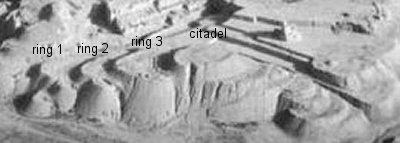

detail of circular fortifications in Susa, Iran (left), and comparison to
remains of rings at Pampa Aullagas (Bolivia).
Further research tells us that King Memnon built the circular walls at Ecbatana and also at Susa, but, here is another interesting part, that King Memnon was a nephew of King Priam of Troy, he is said to have ruled all the way from Susa to Troy and came to the aid of the Trojans with a large army until being killed on the battlefield by Achilles. Since both the fortifications at Ecbatana and Susa had the same form, they may possibly have been modelled on earlier fortifications such as those of Atlantis which Memnon may have heard of through his mother, Eos - which means "titan of the dawn" and said to have dwelt originally on the edge of Oceanus. Additionally, Memnon came from Ethiopia - and Ethiopia stretched at one time right across Africa as far as wht we call the "Atlantic" but was was previously called "The Ethiopian Sea". There were said to be two Ethiopias, the one in Africa and the other on the other side of this Ocean - "referring to the western ends of the earth, when Dawn and the sun spreads over the earth starting from the east they journey west to Oceanus near land of the Ethiopians toward the sunset and the Atlas Mountains." This Ethiopia must therefore be in South America possibly what we now call "Brasil" and the Atlas mountains are what today we call the "Andes".
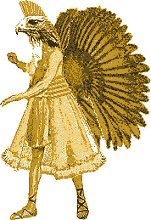

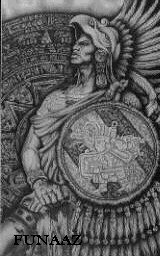

Above, Assyrian god with eagle head mask and feathered headdress on the back,
native American costume with circular headdress on back,
Aztec eagle mask headdress with feathers,
American eagle dance illustration showing circular headdress on the back.



Above, left and centre, Assyrian god with eagle mask and feathered headdress, right
traditional Mexican eagle mask headdress.
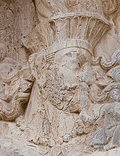
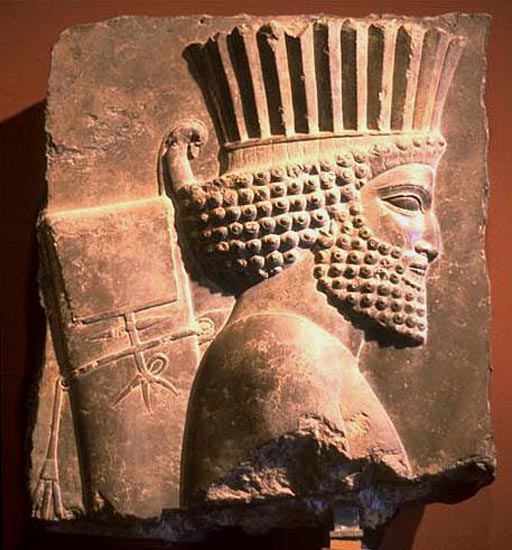

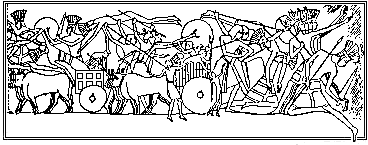
Elamite headdress 1000bc,
Persian headgear, South American Indian headdress,
Sea Peoples with high feathered headdresses.
 "The New Atlantis" by Sir Francis Bacon, 1624 published 1627...
"The New Atlantis" by Sir Francis Bacon, 1624 published 1627...
YOU
SHALL UNDERSTAND THAT ABOUT THREE THOUSAND YEARS AGO, or somewhat more,
the Navigation of the world (specially for remote voyages) was greater
than at this day…. Whether it was, that the example of the Ark, that
saved the remnant of men from the Universal Deluge, gave men confidence
to adventure upon the waters, or what it was; but such is the Truth.
The Phoenicians, and specially the Tyrians, had great fleets. So had
the Carthaginians their colony, which is yet further West. Towards the
east the shipping of Egypt, and of Palestine was likewise great. China
also, and the great Atlantis, (that you call America) which have now
but junks, and canoes, abounded then in tall ships.
At the same time, and an Age after, or more, the inhabitants of the
great Atlantis did flourish…..Yet so much is true, that the said
country of Atlantis, as well that of Peru then called Coya, and that of
Mexico then called Tyrambel, were mighty and proud kingdoms, in arms,
shipping, and riches so mighty as at one time (or at least within the
space of 10 years) they both made two great expeditions, they of
Tyrambel through the Atlantic to the Mediterranean Sea, and they of
Coya through the South Sea…..But whether it were the ancient Athenians,
that had the glory of the Repulse, and resistance of these forces, I
can say nothing. But certain it is, there never came back, either ship,
or man, from that voyage.
But the Divine revenge overtook not long after those proud enterprises.
For within less than the space of one hundred years, the Great Atlantis
was utterly lost and destroyed not by a great earthquakes as your man
saith (for that whole tract is little subject to earthquakes); but by a
particular Deluge or Inundation. Those countries having, at that day,
far greater rivers, and far higher mountains, to pour down waters, than
any part of the Old World. But it is true, that the same inundation was
not deep; not past forty feet in most places from the ground. So that
although it destroyed man and beast generally, yet some few wild
inhabitants of the wood escaped. For as for men, although they had
buildings in many places, higher than the depth of the water, yet that
inundation, though it were shallow, had a long continuance: whereby
they of the Vale, that were not drowned, perished for want of food, and
other things necessary.
So as marvel you not at the thin population of America, nor at the
rudeness and ignorance of the people…..and having in their mountain
regions been used to clothe themselves with the skins of tigers, bears
and great hairy goats, when after they came down into the valley, they
found the intolerable heats which are there, and knowing no means of
lighter apparel they were forced to begin the custom of going naked,
which continueth to this day. Only they take great delight in the
feathers of birds. So you see, by this main accident of Time, we lost
our trafick with the Americas, with whom we had most commerce."
Extracted from "New Atlantis" by Sir Francis Bacon, published
posthumously in 1627.
Francis Bacon writing in 1624 says 3,000 years previously the ships of Atlantis (which he identifies as South America) conducted a great commerce, then he says that within space of one hundred years, the Great Atlantis was utterly lost and destroyed, therefore his date for the end of Atlantis was 1276BC.
He also notes that it was "not by a great earthquakes as your man saith; but by a particular Deluge or Inundation" which is correct for a location on the Altiplano.
It seems very improbable that the 10,000 chariots and 1200 ships would
have set out from the Altiplano, and we have seen above how these numbers tie in with
the Persian forces attacking Athens.
But since Atlantis controlled a great empire, in the earlier stages of the war
it could have dispatched ships and
men from other parts of the empire and it is remarkable how Sir Francis Bacon describes two great fleets
setting out from Peru and Mexico respectively and separated by the space of only 10 years - remarkably similar
to the time scale for the invasions of the "Sea Peoples".
And how could Sir Francis Bacon know all these details about Atlantis being
destroyed and
cut off by a great inundation and its people leaving the mountains to come down into the valleys as well
as the details of the two great invasiosns separeated by the space of 10 years? Well, the great Spanish historian
Sarmiento de Gamboa who wrote the official
"History of the Incas" was at one time captured by a
ship belonging to Sir Walter Raleigh and subsequently brought to England where he was presented at the English Court.
It seems probable that he would have met Francis Bacon and passed on his histories of South America
and the Incas, incidentally also inspiring Sir Walter Raleigh who set out for that continent in his own quest
to find "El Dorado".
The identification of Peru with Coya is particularly interesting because the Quechua name
for the southern part of their empire around the Altiplano was "Colla" and the double L in Spanish is pronounced as "Y"
so that would have been, "Coya".
The inclusion by Sir Francis Bacon of Mexico is very interesting
because of the plots of 10 x 10 stades (similar to Plato's description)
found there. The fleet from Mexico would have sailed through the
Mediterranean, but the fleet from Peru would probably have landed in
the Persian Gulf, adding to the forces of King Memnon - the very same
who built the circular defences at Susa and was a nephew of the King of
Troy and is said to have come to the aid of the King of Troy with a
confederation of nations…..
Spanish historian Agustin Zarate [30] writing in 1556 said "Plato's computation of nine thousand years is no argument that it is a fable; for according to Eudoxus these were not solar but lunar years, reckoned by the Egyptian calendar. The time was therefore nine thousand months or seven hundred and fifty years." Zarate also says of the Andes in his time..."These highlands and mountains are very difficult for travellers since they are densely wooded... The ground is consequently so dark that one has to proceed with great care... For the roots of the trees come up through it, covering the whole mountain and making the cutting of roads for horses very difficult."
Sarmiento de Gamboa [29] in 1572 repeated and expanded upon Zarate. He was of the opinion that South America was "the Atlantic Island" also called "Isla Atlantica", ("Isla Atlanticus in Latin") or "Atlantis" but thought that an eastern portion between Brasil and Cadiz had broken off and sank. He also tells us that in Peru, Viracocha after a great flood adopted five pairs of twin sons. And he was of the opinion that the end or war of Atlantis took place ... "when Aod governed Israel in 1320 BC … According to all the chronicles Solon lived in the time of King Tarquinius Priscus, King of Rome, Josiah being King of Israel at Jerusalem in 610 BC. And from this period to the time when the Atlanteans put the blockade upon the Athenians was 9,000 lunar years, which referring to solar years comes to 869 years. And both added together is the aforementioned date." In other words, Pedro Sarmiento de Gamboa specifically spells out 1320 BC as the date for the end of Atlantis using a calendar of lunar months, but this would be 1283 BC if we use sidereal lunar months. I am completely surprised that of all the many investigators and academics who have studied the subject, none to my knowledge has picked up on this before. In fact, Gamboa does not even discuss the possibility that Plato might really mean nine thousand solar years since it is so obvious to him that lunar years are intended, and I think it is important to give him credit as an astronomer and classical historian who, living in the Renaissance age, knew the difference between solar and lunar years and what was intended in Plato's text.

In the sixteenth century, the identification of South America as Atlantis must have circulated around Europe, since many prominent people such as Elizabethan philosopher Dr John Dee identified with it and it was also written about in Italy by Girolamo Fracastoro. There are said to be no copies existing today of the original Greek text as written by Plato, but what Plato wrote was said to have been translated into Latin in the fifteenth century by the Italian, Marsilio Ficino.

Sarmiento de Gamboa was not the only one to think that the events Plato described took place around the time of the Trojan War. Sir Isaac Newton had a similar opinion (perhaps based upon or influenced by the writings of Gamboa and Zarate), and tells us that the Atlantis events took place two generations before the Trojan War, and that the Egyptians exagerated the date to give more antiquity to their own nation, while the Greeks, not knowing where the island continent was, assumed it to have sunk. The details are given in his "The Chronology of Ancient Kingdoms" - "The time therefore when these things were done is by Solon limited to the age of Neptune, the father of Atlas; for Homer tells us, that Ulysses presently after the Trojan war found Calypso the daughter of Atlas in the Ogygian Island, perhaps Gadir; and therefore it was but two Generations before the Trojan war. This is that Neptune, who with Apollo or Orus fortified Troy with a wall, in the Reign of Laomedon the father of Priamus, and left many natural children in Greece, some of which were Argonauts, and others were contemporary to the Argonauts; and therefore he flourished but one Generation before the Argonautic expedition, and by consequence about 400 years before Solon went into Egypt: but the Priests of Egypt in those 400 years had magnified the stories and antiquity of their Gods so exceedingly, as to make them nine thousand years older than Solon, and the Island Atlantis bigger than all Africa and Asia together, and full of people; and because in the days of Solon this great Island did not appear, they pretended that it was sunk into the sea with all its people: thus great was the vanity of the Priests of Egypt in magnifying their antiquities."
So it seems likely that Sir Isaac Newton may have been correct with a date for the end of Atlantis as two generations before the Trojan War, this being similar to the dates proposed by Bacon (1276 BC) and by Sarmiento de Gamboa (1283 BC) and perhaps it was this massive inundation of their homeland which prompted the "Sea Peoples" to venture forth and invade the Eastern Mediterranean.
Atlantis the Red Island
Isaac Newton by the way tells us that the Phoenicians came originally from the Red Sea and were
originally Edomites who were a red colour, thus,
"The Red Sea had its name not from its colour,
but from Edom and Erythra, the names of Esau, which signify that colour".
When they were conquered by King
David of Israel, some of them fled to Egypt, others to Phoenicia, and others to the Persian Gulf which also became known as the
Erythrian Sea. They were credited with knowledge of writing, mathematics, astronomy
and ship building and many places were subsequently called Erythria.
"And this flight gave occasion
to the Philistims to call many places Erythra, in memory of their being Erythreans or Edomites,
and of their coming from the Erythrean Sea."
To quote Newton again, "These Edomites who fled to the Mediterranean, translating the word Erythrća into that of Phśnicia, give the name of Phśnicians to themselves, and that of Phśnicia to all the sea-coasts of Palestine from Azoth to Zidon. And hence came the tradition of the Persians, and of the Phśnicians themselves, mentioned by Herodotus, that the Phśnicians came originally from the Red Sea, and presently undertook long voyages on the Mediterranean.
So the Erythrian Sea means the sea from which the Red Men came and some people think that the Erythrian Sea might also have been an early name for the Atlantic Ocean. We should note also that Erythia is described as being a red island... "Geryon (or Geryones) was a three-bodied, four-winged giant who dwelt on the red island of Erytheia in the westernmost reaches of the earth-encircling River Ocean." And when Hercules quote "reached Erytheia he camped on Mount Atlas." So Mount Atlas was according to some writers, located on the red island of Erythia on the western side of the Ocean.....
Anyone who visits Oruro on the Bolivian Altiplano, cannot fail to note the red colour of the soil, and the red or copper colour of the people themselves...
As pointed out by R. Cedric Leonard, Plato was not the first to use the name Atlantis since it occurs also in Herodotus.
Atlas King of Atlantis
The Atlantic was called after Atlantis as the sea containing the island of Atlantis and Atlas the first King of Atlantis. But Atlas was mentioned about 400 years before Herodotus by two famous Greek writers, namely Homer and Hesiod. We find Atlas mentioned by Homer in the Odyssesy. After the war of Troy, Ulysses goes on a long voyage and finds himself on a lonely island far away in the middle of the Sea. The island is well-wooded and a goddess lives there, the child of the malevolent Atlas, who knows the sea in all its depths and with his own shoulders supports the great columns that hold earth and sky apart."
He is also mentioned by Hesiod, "Now Iapetus took to wife the neat-ankled maid Clymene, daughter of Ocean, and went up with her into one bed. And she bare him a stout-hearted son, Atlas ... And Atlas through hard constraint upholds the wide heaven with unwearying head and arms, standing at the borders of the earth before the clear-voiced Hesperides; for this lot wise Zeus assigned to him."
"Atl" in the Aztec "nahuatl" language means "water" or "in the middle" or "in the middle of water". We might wonder how an Aztec word came to be found as part of the name of one of the Greek gods. The explanation is that the Greek pantheon of gods is thought to have been borrowed from the Egyptian, or from Near Eastern origins. And the story of Atlas supporting columns that hold earth and sky apart is very similar to the Egyptian idea of Nut (the sky) being held apart from her brother, Geb (the earth) by their father Shu, who corresponds to the Greek, Atlas.
In later times, the Atlas mountains came to be associated with the range of that name in present day Morroco, but if we are correct in our assumption that the island of Atlantis is South America, how much more logical it would be that the actual original mountains of Atlas would be what today are called the Andes, which rise to double the height of their counterparts in Morocco. The Altiplano is a level plateau, 12,000 feet up in the sky flanked on either side by the Andes mountains which seem as if they are "pillars keeping the sky up". Furthermore, when we examine this region of the Altiplano in Bolivia, we find that this high plateau is known locally as "the place where Heaven meets Earth."

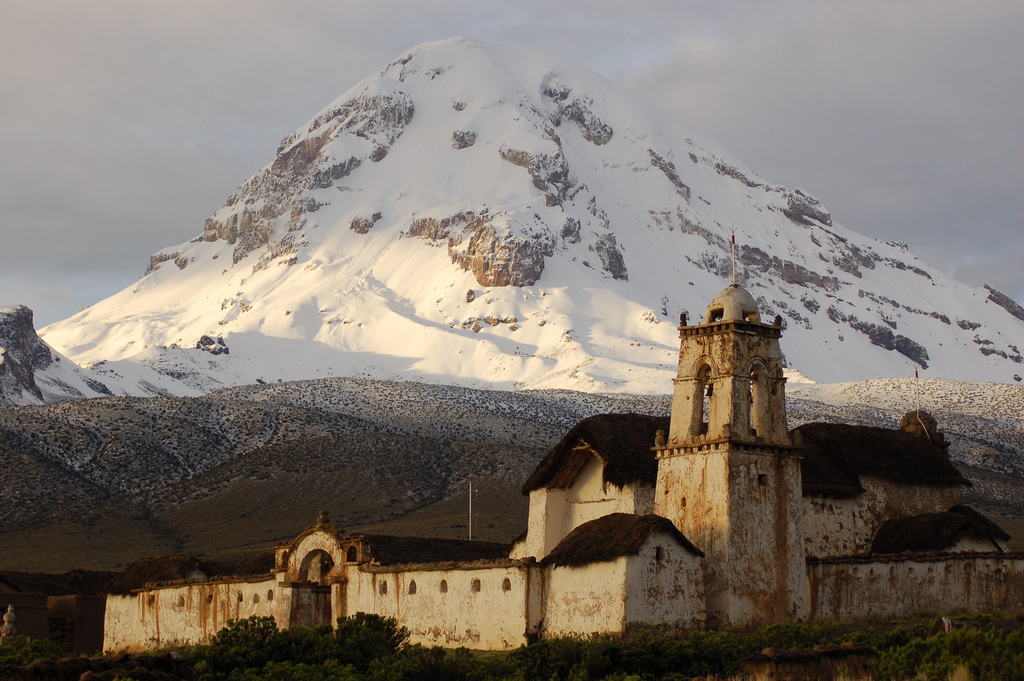
Gallery of photos around the Altiplano, in the region of Sajama,
volcan Tunupa and the Salar de Uyuni
According to a later story invented to describe the origin of the heaven-bearing Atlas Mountains of North Africa, put forward by Polyidus, "makes Atlas a shepherd: according to him, Perseus arrived on the scene, and Atlas asked who he was and where he had come from; and when Perseus' words failed to persuade him to allow him to pass, he was compelled to show him the Gorgon's face and turned him to stone; and the mountain was called Atlas after him." Thus Atlas became a mountain in Libya (North Africa), consequently quote "Late Hellenistic and Roman poets reimagined the Titan Atlas as a giant ruler in the westernmost lands, and early modern translators such as Thomas Bulfinch made of that hint a King Atlas, a mythical King of Mauretania, west of Libya, who provided an alternative etiological origin-tale for the Atlas Mountains of North Africa."

The original Atlas however whose columns held up the Heavens, quote "also instructed (Hercules) quite freely in the knowledge of astrology. For Atlas had worked out the science of astrology to a degree surpassing others and had ingeniously discovered the spherical arrangement of the stars, and for that reason was generally believed to be bearing the entire firmament upon his shoulders."
"Atlas along with Phoebe were said to have ruled over the power of the moon."
We should note then, that although often shown as carrying the globe on his shoulders, it was not originally the Earth which Atlas carried, but the celestial sphere - the sky, the heavens etc.
Time to look then at the lost Andean world of Astronomy, for which they have never been given credit but remains preserved in the arrangement of the calendar wall and in the icons on the Gate of the Sun at Tiwanaku, a soli-lunar calendar surpassing in sophistication anything found elsewhere in the ancient world.
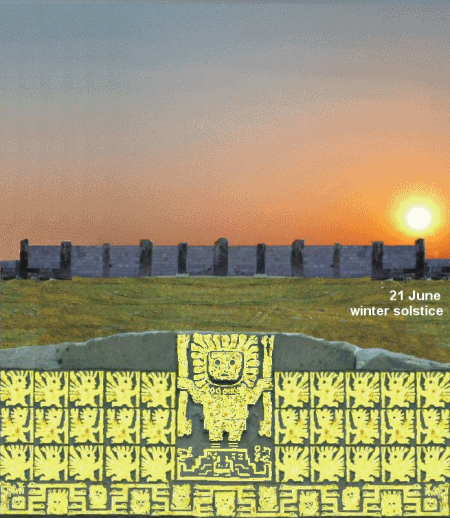
The actual calendar is not the Gate of the Sun but the wall with 11 pillars
behind it.
The 11 small icons on the freize of the Gate of the Sun represent these 11 pillars
and
throughout the year the sun sets over the pillars
dividing the year into 20 months of 18 days.

Above, Each chasqui or winged figure on the Gate of the Sun
represents 1 solar year
and every
3 years
was equal to
40 sidereal lunar months
represented by 40 condors heads.
At the end of thirty years, an extra lunar month was added to the calendar
to synchronise the two calendars
(making 401 sidereal lunar months)
The Tiwanaku calendar was a soli-lunar calendar counting
Inca "years" of 12 sidereal months
1 solar year of 20 months of 18 days + 5.24days
18 solar years = 20 Inca lunar years of 12 sidereal months
3 solar years = 40 lunar sidereal months, (2 x "Zocam" years) or 37 synodic lunar months (1 "Acrotom" year)
30 solar years = 20 Zocam years = 10 Muisca Acrotom years
when a lunar month was added to correct the calendar
represented by the 30 chasquis in columns of 3 chasquis

Decoding the Tiwanaku calendar
visit www.atlantisbolivia.org bookstore for link to paperback edition "Decoding the Tiwanaku Calendar"
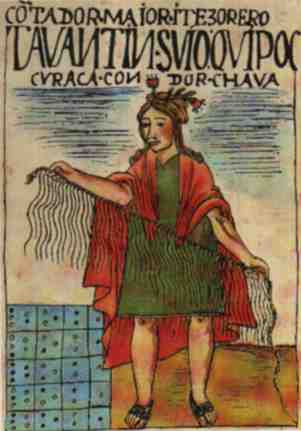
Decoding the quipu mathematics
pre-Columbian population of America
When European explorers travelled through Amazonia in the eighteenth century, they thought they were in pristine forest. They were unaware that the region at one time had a population in the millions although Spanish Conquistador Francisco de Orellana who travelled the Amazon in 1542 from the Andes to the sea had reported large populations including stone built cities.

Amazon cities click for report

earthmovers of the Amazon by Charles C. Mann

the pristine myth by William M. Denevan
Department of Geography, University of Wisconsin
In the wet season, vasts tracts of Amazonia and the Beni region of Bolivia become submerged by floodwaters. The race of people who built the canals and artificial pond complexes of South America were not farmers, but people who chose an "aquatic" environment in a flat landscape ideal for canals, ponds, and islands as their preferred habitat.The peoples of the Beni flood plains, for example, lived on artificial mounds and built long straight causeways and canals for transportation, they also created great numbers of huge artificial ponds probably used for the capture or storage of fish stocks.
Unnatural Histories (TV series)
Episode 3: Amazon
First aired on Thursday 23 June 2011. The final episode looks at the Amazon rainforest - billed as the world's
last great wilderness. However, the discovery of geoglyphs uncovered following deforestation in the 1970s and
terra preta, provide growing evidence for ancient cities in the heart of the 'virgin forest'. Alceu Ranzi,
a Brazilian geographer, is accredited with first discovering the geoglyphs whilst flying over Acre.
The documentary presents evidence that Francisco de Orellana, rather than exaggerating his claims as previously
thought, was correct in his observations that a complex civilization was flourishing along the Amazon in the 1540s.
It is believed that the civilization was later devastated by the spread of diseases from Europe, such as smallpox.
Some 5 million people may have lived in the Amazon region in 1500, divided between dense coastal settlements, such
as that at Marajó, and inland dwellers. By 1900 the population had fallen to 1 million and by the early 1980s it
was less than 200,000.

pre-Columbian fish farming in Bolivia and Amazon by Clark Erickson PhD

Beni, immense number of artificial ponds
High resolution Google Earth satellite imagery shows remains of extensive systems of
artifical canals, islands, harbours and ponds all over the Americas, the following links cover areas of rivers Parana,
Paraguay, the Pantanal, Amazonas and Orinocco.

rio Parana canals, ponds and islands

rio Paraguay artificial canals, ponds and islands

canals and ponds rio Amazon to Manaus

canals and ponds rio Amazon west from Manaus
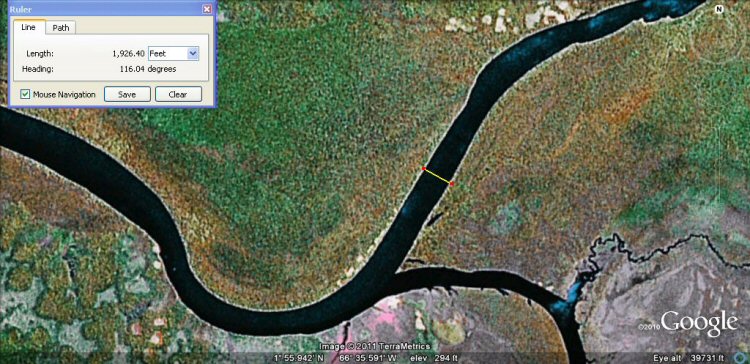
man-made canal joining rio Orinocco to rio Amazon
rio Parana delta canals
Corrientes
Pantanal
Tabasco, Mexico canals gallery

concentric ringed harbour, Louisiana
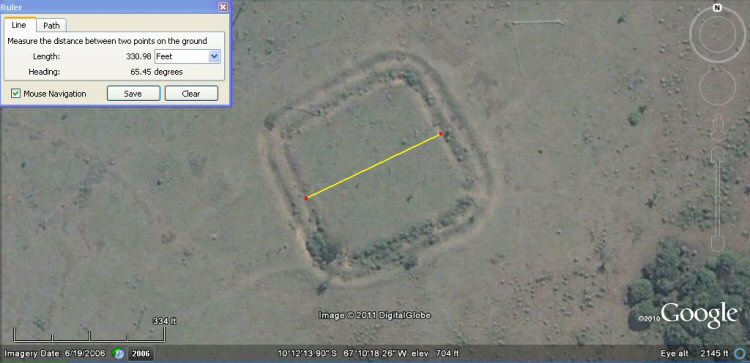
the above earthwork in Brasil measures 200 Sumerian cubits wide.....

the above earthwork in Brasil measures 500 Sumerian cubits wide.....
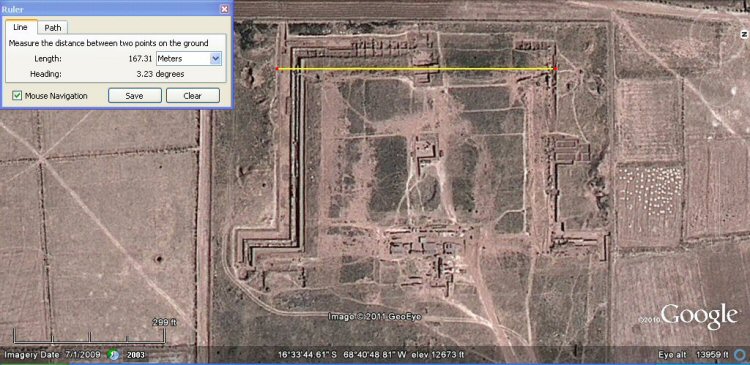
above, the Puma Punka in Tiwanaku measured 500 Sumerian feet or 100 Sumerian double yards wide.....
Click here for the Atlantis Stade - measurement units in the ancient Americas, Egypt and Sumeria
The above links to "geoglyphs" page show remains of ancient fossilised systems of land
cultivation on the Altiplano
accompanied by hilltops surrounded with concentric
irrigation channels in regions hit extensively
by earthquakes bringing to an end the culture of that period.
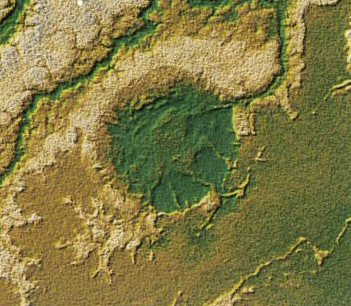
Above, the Iturralde crater in the Beni region of Bolivia
Did a meteorite help sink Atlantis?
the elephants of Atlantis

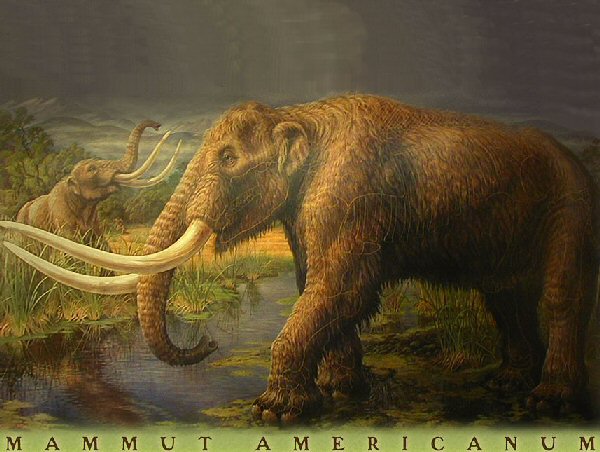
One of the frequently read comments is that there were no elephants in South America.

Photo above shows remains of
mastodon (large mammal belonging to the elephant family)
head and tusks in Tarija museum, not far from the Altiplano.

Photo above shows remains of
mastodon (large mammal belonging to the elephant family)
in Tarija museum, photo:Eduardo Montano.
Animal sacrifice in Atlantis
Another comment re bulls sacrifice, the animals which were sacrificed were probably llamas, since this is common practice on the Altiplano as was drinking a mixture of the llama's blood from golden goblets in ancient rituals and even today offerings are thrown into the sacred fire as offerings to the gods…
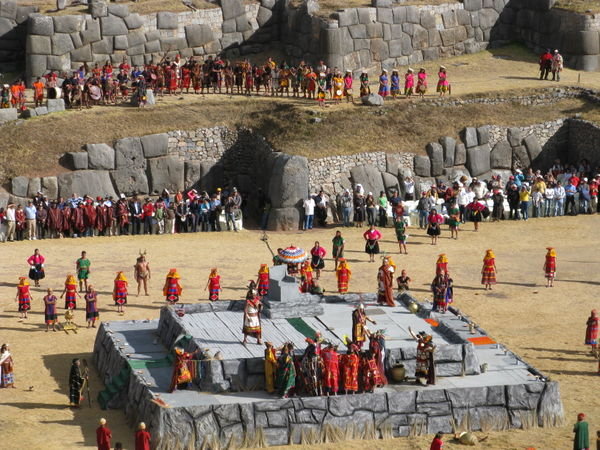
llama sacrifice

llama sacrifice
“When therefore, after slaying the bull in the accustomed manner, they had burnt its limbs, they filled a bowl of wine and cast in a clot of blood for each of them; the rest of the victim they put in the fire, after having purified the column all round. Then they drew from the bowl in golden cups and pouring a libation on the fire, they swore that they would judge according to the laws on the pillar,”
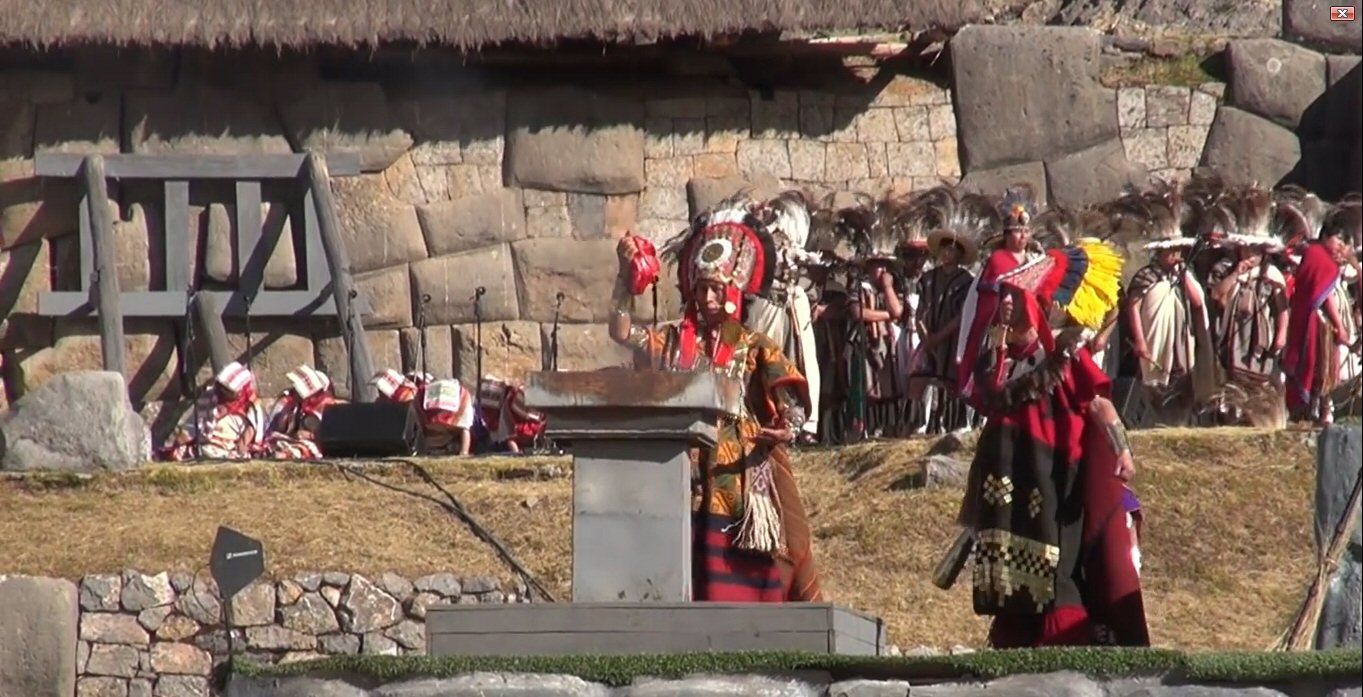
Inti Raimi, burning the sacrifice on the sacred fire.


Inti Raimi, drinking from golden goblets, sacred fire, llama sacrifice on youtube
Plato stated that he gave all the original names Greek equivalents "to make it more agreeable to his readers", it is important to remember that he never actually visited the site himself and neither the ancient Greeks nor ancient Egyptians had probably ever seen or heard of a llama, thus "bull" was substituted, just as "trireme" was substituted for whichever type of ship or boat was originally used.
Full Paper part I submitted to Altantis Conference Athens 2008 PDF CLICK HERE
Full Paper part II submitted to Altantis Conference Athens 2008 PDF CLICK HERE
Full Paper part III submitted to Altantis Conference Athens 2008 PDF CLICK HERE
Youtube
The 50 points test for Atlantis part 1 of 2 documentary
Youtube
The 50 points test for Atlantis part 2 documentary


Atlantis - the Altiplano Bolivia versus Thera, Crete. Which one actually matches the description?

Additonal material
 skeleton of ancient horse found in Peru
skeleton of ancient horse found in Peru

pre Columbian horses in America


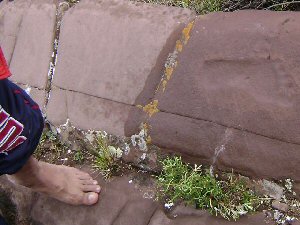
Human footprint 5 to 15 million years old found in Bolivia click for report

Snake sculpture called the 'Monolito Cobra' photographed by Eduardo Montańo
of Atlantis Bolivia Showroom and Tours at
the ruined ancient temple of Chukuperka by the shore of Lake Titicaca.

Atlantis' Legendary Metal Found in Shipwreck
In Plato’s story, It is not Atlantis which is the ideal state, but Athens.
From the “Timaeus”
“Crit. Then listen, Socrates, to a tale which, though strange,
is certainly true, having been attested by Solon,
who was the wisest of the seven sages."
The story continues introducing the theme of Atlantis as told to Solon by the Egyptian priests…….
Of course, the above may be nothing more than a literary device
of Plato, but the fact remains that the geographic features do fit the
Altiplano, which has the further advantage of all the sites proposed
for Atlantis that it is the only one where the prospective tourist can
visit and see for himself most of the details Plato spoke of, the level
rectangular plain enclosed by mountains, the remains of an island sunk
by earthquakes and still covered by fossilised sea sediments, remains
of concentric rings of land, black, red and white stones, the metals
gold, silver, tin, copper and the mysterious “orichalcum” – an alloy of
gold and copper, the hot and cold springs and finally, remains of
mastodons – the “elephants” which Plato said were at one time numerous
in the continent.
It would hardly have been necessary for Plato to invent such geographic details as these, if he had known all the
details of the Trojan war then surely it would have been easier to have used that to illustrate the finest deeds of
his ideal state of Athens, or if the attacking forces were the Sea Peoples then it was not the Athenians
who defeated the Sea Peoples but the Egyptians.
So Atlantis becomes a great power, with 10,000 chariots and 1200 ships although as we have seen, 1200 was the
number of ships used in the Persian fleet and also sent by the Greeks against Troy so in the end the story apart
from the geographic description of South America, has elements both of the “Sea Peoples” as the confederated
nations, and the Trojan and Persian Wars as the finest of the deeds the Athenians
accomplished.
But in the geographic description exist details which could not have been invented. The rectangular shaped level
plain in the centre of the island midway along its longest side,
the orichalcum which Plato considered “being more precious in those
days than anything except gold”, this Andean alloy of gold and
copper, “sparkling like
red fire” and then there are the twins, all the
first inhabitants are born in pairs, just like in the Andes where the
first inhabitants were born in pairs etc etc.
Not
only does Bolivia, as it is called today, have all the above mentioned
features, but even the Atlantis legend itself may have it’s origins in
Bolivian legend since “the legend of the Desaguadero” tells of a city
punished by the gods and sinking beneath the waters of the (inland)
sea, surely not a parallel to Plato’s story but the origin itself of
Plato’s story of Atlantis and possibly brought to Greece via Egypt as
Plato claimed and brought to Egypt by captive warriors of "the Sea
Peoples", or maybe the traders who
first brought coca to Egypt since tobacco and coca from the Andes have
been found in Egyptian mummies using modern scientific methods of
investigation.

History of reed ship boatbuilding and expeditions


Tangaroa balsa raft from South America to Polynesia
Who's who in ancient Greek history
 comparison of translations of Plato
comparison of translations of Plato
Or he could have used the Persian Wars and how the Persian Empire
was defeated by the Athenians, but then Plato was not too fond of
democracy and wanted to show how an Athens governed by philosopher
kings had defeated a great empire, so is it for that reason that he
pushed the date of events back to 9,000 years before Solon?

Above, tourist map of site at Atlantis/Pampa Aullagas
The village of Pampa Aullagas
welcomes visitors to the site
at Pampa Aullagas in Bolivia.
Youtube videos were removed by Youtube.

Bolivia expeditions October/November 2011 report pdf
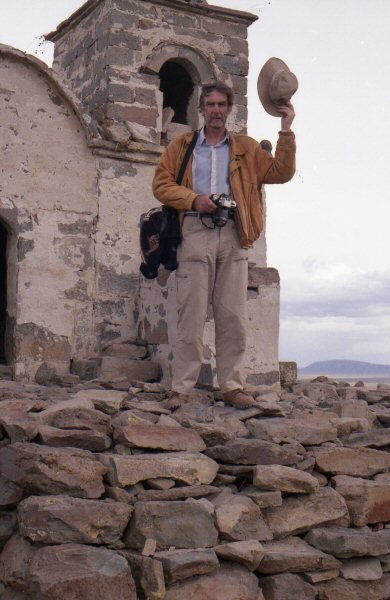
Jim Allen e-mail address
webatlantis@hotmail.com
pagina web en castellano haga click
Plato's Atlantis
“The whole country was said by him to be very lofty and precipitous on the side of the sea, but the country immediately about and surrounding the city was a level plain, itself surrounded by mountains which descended towards the sea; it was smooth and even, and of an oblong shape, extending in one direction three thousand stadia, but across the centre inland it was two thousand stadia. This part of the island looked towards the south, and was sheltered from the north. The surrounding mountains were celebrated for their number and size and beauty, far beyond any which still exist, having in them also many wealthy villages of country folk, and rivers, and lakes, and meadows supplying food enough for every animal, wild or tame, and much wood of various sorts, abundant for each and every kind of work.
I will now describe the plain, as it was fashioned by nature and by the labours of many generations of kings through long ages. It was for the most part rectangular and oblong, and where falling out of the straight line followed the circular ditch. The depth, and width, and length of this ditch were incredible, and gave the impression that a work of such extent, in addition to so many others, could never have been artificial. Nevertheless I must say what I was told. It was excavated to the depth of a hundred, feet, and its breadth was a stadium everywhere; it was carried round the whole of the plain, and was ten thousand stadia in length. It received the streams which came down from the mountains, and winding round the plain and meeting at the city, was there let off into the sea. Further inland, likewise, straight canals of a hundred feet in width were cut from it through the plain, and again let off into the ditch leading to the sea: these canals were at intervals of a hundred stadia, and by them they brought down the wood from the mountains to the city, and conveyed the fruits of the earth in ships, cutting transverse passages from one canal into another, and to the city. Twice in the year they gathered the fruits of the earth-in winter having the benefit of the rains of heaven, and in summer the water which the land supplied by introducing streams from the canals.
And Poseidon, receiving for his lot the island of Atlantis, begat children by a mortal woman, and settled them in a part of the island, which I will describe. Looking towards the sea, but in the centre of the whole island, there was a plain which is said to have been the fairest of all plains and very fertile. Near the plain again, and also in the centre of the island at a distance of about fifty stadia, there was a mountain not very high on any side.
In this mountain there dwelt one of the earth born primeval men of that country, whose name was Evenor, and he had a wife named Leucippe, and they had an only daughter who was called Cleito. The maiden had already reached womanhood, when her father and mother died; Poseidon fell in love with her and had intercourse with her, and breaking the ground, enclosed the hill in which she dwelt all round, making alternate zones of sea and land larger and smaller, encircling one another; there were two of land and three of water, which he turned as with a lathe, each having its circumference equidistant every way from the centre, so that no man could get to the island, for ships and voyages were not as yet. He himself, being a god, found no difficulty in making special arrangements for the centre island, bringing up two springs of water from beneath the earth, one of warm water and the other of cold, and making every variety of food to spring up abundantly from the soil. He also begat and brought up five pairs of twin male children; and dividing the island of Atlantis into ten portions, he gave to the first-born of the eldest pair his mother's dwelling and the surrounding allotment, which was the largest and best, and made him king over the rest; the others he made princes, and gave them rule over many men, and a large territory. And he named them all; the eldest, who was the first king, he named Atlas, and after him the whole island and the ocean were called Atlantic. All these and their descendants for many generations were the inhabitants and rulers of divers islands in the open sea; and also, as has been already said, they held sway in our direction over the country within the Pillars as far as Egypt and Tyrrhenia.
Now Atlas had a numerous and honourable family, and they retained the kingdom, the eldest son handing it on to his eldest for many generations; and they had such an amount of wealth as was never before possessed by kings and potentates, and is not likely ever to be again, and they were furnished with everything which they needed, both in the city and country. For because of the greatness of their empire many things were brought to them from foreign countries, and the island itself provided most of what was required by them for the uses of life. In the first place, they dug out of the earth whatever was to be found there, solid as well as fusile, and that which is now only a name and was then something more than a name, orichalcum, was dug out of the earth in many parts of the island, being more precious in those days than anything except gold. There was an abundance of wood for carpenter's work, and sufficient maintenance for tame and wild animals. Moreover, there were a great number of elephants in the island; for as there was provision for all other sorts of animals, both for those which live in lakes and marshes and rivers, and also for those which live in mountains and on plains, so there was for the animal which is the largest and most voracious of all. Also whatever fragrant things there now are in the earth, whether roots, or herbage, or woods, or essences which distil from fruit and flower, grew and thrived in that land; also the fruit which admits of cultivation, both the dry sort, which is given us for nourishment and any other which we use for food-we call them all by the common name pulse, and the fruits having a hard rind, affording drinks and meats and ointments, and good store of chestnuts and the like, which furnish pleasure and amusement, and are fruits which spoil with keeping, and the pleasant kinds of dessert, with which we console ourselves after dinner, when we are tired of eating-all these that sacred island which then beheld the light of the sun, brought forth fair and wondrous and in infinite abundance. With such blessings the earth freely furnished them; meanwhile they went on constructing their temples and palaces and harbours and docks. And they arranged the whole country in the following manner:
First of all they bridged over the zones of sea which surrounded the ancient metropolis, making a road to and from the royal palace. And at the very beginning they built the palace in the habitation of the god and of their ancestors, which they continued to ornament in successive generations, every king surpassing the one who went before him to the utmost of his power, until they made the building a marvel to behold for size and for beauty. And beginning from the sea they bored a canal of three hundred feet in width and one hundred feet in depth and fifty stadia in length, which they carried through to the outermost zone, making a passage from the sea up to this, which became a harbour, and leaving an opening sufficient to enable the largest vessels to find ingress. Moreover, they divided at the bridges the zones of land which parted the zones of sea, leaving room for a single trireme to pass out of one zone into another, and they covered over the channels so as to leave a way underneath for the ships; for the banks were raised considerably above the water. Now the largest of the zones into which a passage was cut from the sea was three stadia in breadth, and the zone of land which came next of equal breadth; but the next two zones, the one of water, the other of land, were two stadia, and the one which surrounded the central island was a stadium only in width. The island in which the palace was situated had a diameter of five stadia. All this including the zones and the bridge, which was the sixth part of a stadium in width, they surrounded by a stone wall on every side, placing towers and gates on the bridges where the sea passed in. The stone which was used in the work they quarried from underneath the centre island, and from underneath the zones, on the outer as well as the inner side. One kind was white, another black, and a third red, and as they quarried, they at the same time hollowed out double docks, having roofs formed out of the native rock. Some of their buildings were simple, but in others they put together different stones, varying the colour to please the eye, and to be a natural source of delight. The entire circuit of the wall, which went round the outermost zone, they covered with a coating of brass, and the circuit of the next wall they coated with tin, and the third, which encompassed the citadel, flashed with the red light of orichalcum.
The palaces in the interior of the citadel were constructed on this wise:-in the centre was a holy temple dedicated to Cleito and Poseidon, which remained inaccessible, and was surrounded by an enclosure of gold; this was the spot where the family of the ten princes first saw the light, and thither the people annually brought the fruits of the earth in their season from all the ten portions, to be an offering to each of the ten. Here was Poseidon's own temple which was a stadium in length, and half a stadium in width, and of a proportionate height, having a strange barbaric appearance. All the outside of the temple, with the exception of the pinnacles, they covered with silver, and the pinnacles with gold. In the interior of the temple the roof was of ivory, curiously wrought everywhere with gold and silver and orichalcum; and all the other parts, the walls and pillars and floor, they coated with orichalcum. In the temple they placed statues of gold: there was the god himself standing in a chariot-the charioteer of six winged horses-and of such a size that he touched the roof of the building with his head; around him there were a hundred Nereids riding on dolphins, for such was thought to be the number of them by the men of those days. There were also in the interior of the temple other images which had been dedicated by private persons. And around the temple on the outside were placed statues of gold of all the descendants of the ten kings and of their wives, and there were many other great offerings of kings and of private persons, coming both from the city itself and from the foreign cities over which they held sway. There was an altar too, which in size and workmanship corresponded to this magnificence, and the palaces, in like manner, answered to the greatness of the kingdom and the glory of the temple.
In the next place, they had fountains, one of cold and another of hot water, in gracious plenty flowing; and they were wonderfully adapted for use by reason of the pleasantness and excellence of their waters. They constructed buildings about them and planted suitable trees, also they made cisterns, some open to the heavens, others roofed over, to be used in winter as warm baths; there were the kings' baths, and the baths of private persons, which were kept apart; and there were separate baths for women, and for horses and cattle, and to each of them they gave as much adornment as was suitable. Of the water which ran off they carried some to the grove of Poseidon, where were growing all manner of trees of wonderful height and beauty, owing to the excellence of the soil, while the remainder was conveyed by aqueducts along the bridges to the outer circles; and there were many temples built and dedicated to many gods; also gardens and places of exercise, some for men, and others for horses in both of the two islands formed by the zones; and in the centre of the larger of the two there was set apart a race-course of a stadium in width, and in length allowed to extend all round the island, for horses to race in. Also there were guardhouses at intervals for the guards, the more trusted of whom were appointed-to keep watch in the lesser zone, which was nearer the Acropolis while the most trusted of all had houses given them within the citadel, near the persons of the kings. The docks were full of triremes and naval stores, and all things were quite ready for use. Enough of the plan of the royal palace.
Leaving the palace and passing out across the three harbours you came to a wall which began at the sea and went all round: this was everywhere distant fifty stadia from the largest zone or harbour, and enclosed the whole, the ends meeting at the mouth of the channel which led to the sea. The entire area was densely crowded with habitations; and the canal and the largest of the harbours were full of vessels and merchants coming from all parts, who, from their numbers, kept up a multitudinous sound of human voices, and din and clatter of all sorts night and day. “
continue to ....
Atlantis Bolivia part 5, resumé 2017, links, subpages and references


